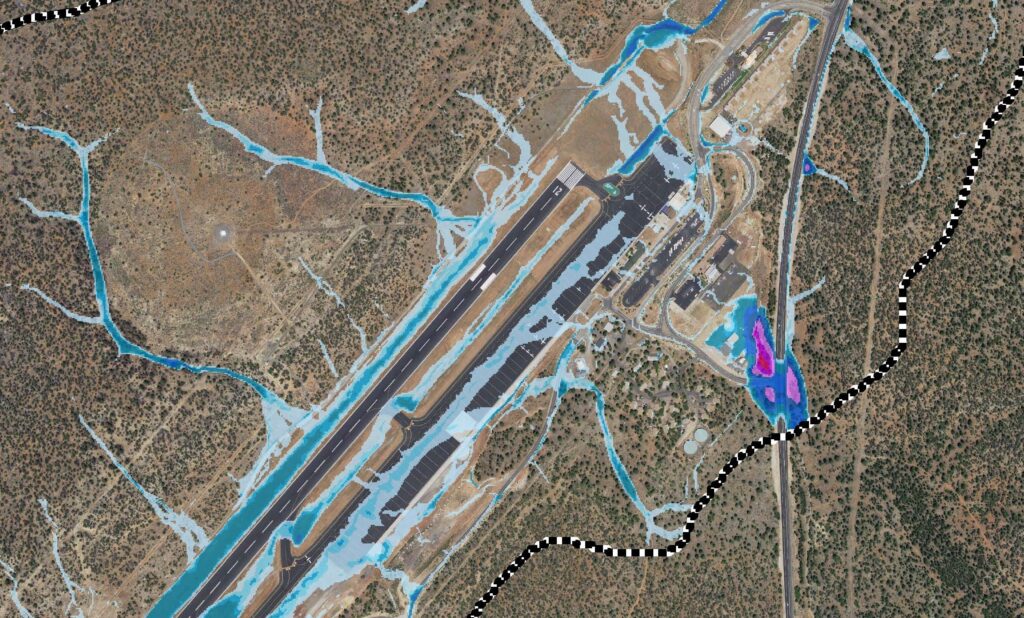Airport Drainage Solutions
Optimizing the future of airports with drainage master plans.
Written by: Bob Haneline, PE | Susanna Mabery

Introduction
An airport master plan is a detailed study required by the Federal Aviation Administration (FAA) to document short-, medium-, and long-term needs over a 20-year interval to support future aviation demands and growth.
A comprehensive drainage master plan (DMP) complements the overall airport master plan. The DMP identifies drainage deficiencies, develops and evaluates improvements, and identifies projects to meet the airport master plan goals and FAA regulations. The DMP also addresses timelines, capital improvement budgets, and permitting challenges.
Planning for future airport growth must accommodate drainage needs while minimizing adverse impacts to adjacent landowners and environments or potentially dangerous conditions at the airport. A good DMP is specifically tailored to the airport and its surrounding community. A robust stakeholder outreach program is important to identifying well-considered, cost-effective solutions.
At Dibble, our flood control practice includes skilled, experienced drainage engineers who thoroughly understand airports.

Plan of Action
Although each DMP is unique, we have found great success by following the three-step approach detailed below.
Data Collection and Existing Conditions Analysis
The DMP begins with a kick-off meeting and document collection. The Dibble team solicits specifics of problems and collects valuable data such as the airport master plan, any previous analyses/designs, and information about existing drainage deficiencies and flood hazards. A topographic survey and field data collection are often performed to model the existing features of the airport and surrounding areas.
The team then performs a hydrologic and hydraulic (H&H) analysis to quantify the amount of stormwater generated during storm events and the response of the airport’s existing drainage infrastructure. This analysis may be performed using traditional one-dimensional (1-D) hydrology software such as HEC-1 and 1-D hydraulic software such as HEC-RAS and SWMM.
Our team also utilizes the more accurate two-dimensional (2-D) H&H modeling approach through programs such as HEC-RAS 2D and FLO-2D. 2-D modeling combines both hydrology and hydraulics in one model, providing a better understanding of existing drainage patterns while limiting unneeded “over-designing” of drainage infrastructure. We always “ground truth” the modeling results by soliciting stakeholder feedback.

Alternative Analysis of Proposed Conditions
After identifying the existing flood hazards, Dibble develops alternatives to correct the issues and reflect future conditions identified in the airport master plan. Similar flood hazards are grouped together to solve multiple problems with common causes, which provides a cost-effective solution.
Dibble seeks to develop practical, constructible, cost-effective alternatives for our clients. We present the preliminary alternatives to airport stakeholders at a public or private meeting to solicit input.
To ensure that every stakeholder’s voice is heard and to remove subjectivity, Dibble develops a numerically weighted matrix to evaluate each alternative. We work with stakeholders to identify scoring categories, criteria, and weights, enabling the project team to achieve consensus on the preferred alternative.

Final DMP, Phase Implementation, and Cost Analysis
The preferred alternatives for drainage improvements are documented in the final DMP. This includes the engineer’s opinion of probable construction cost, phasing implementation, and permitting requirements for each alternative – all of which align with the airport master plan’s planning periods.
Conclusion
Airport DMPs are wise investments in an airport’s overall planning efforts. They identify existing deficiencies and outline needed drainage improvements to implement the airport master plan. The drainage improvement alternatives are FAA compliant and require stakeholder buy-in. The DMP establishes cost-effective improvements and achievable project phasing so the improvements align with the airport’s budget and overall vision.
“Thanks for your work on this project. I couldn’t be happier.”
Chris Andres, City of Chandler, Chandler Municipal Airport Drainage Study
DMP Project Success

Project Name: ADOT – Grand Canyon National Park Airport, Drainage Master Plan
Location: Tusayan, Arizona
Issue: In 2017, ADOT obtained a grant from the FAA to develop a DMP and Water Use Study. The DMP was needed to evaluate drainage patterns, identify deficiencies, and develop solutions to prevent future flooding at the airport. Additionally, ADOT wanted to evaluate the feasibility of capturing, storing, and treating stormwater for use as potable to meet the airport’s growing demands.
Solution: Dibble produced a DMP that identified drainage deficiencies and alternatives to mitigate each issue. Our team identified various drainage improvements, such as infield culvert relocations out of the runway safety area (RSA)/taxiway safety areas (TSAs); installation of a perforated storm drain along a taxiway; drainage improvements near the aircraft apron; and relocation of a nearby wetland to allow for future runway expansion. The study also found that stormwater harvesting is a practical option for the airport.

Project Name: City of Phoenix – Phoenix Sky Harbor International Airport (PHX), Airport Drainage Master Plan Update (DMPU)
Location: Phoenix, Arizona
Issue: PHX needed to update their DMP to be used as a planning and programming tool for anticipated storm drainage system construction in conjunction with extensive airport infrastructure upgrades planned for the next 10 to 20 years.
Solution: Dibble developed the Airport DMPU for PHX. The team verified and updated existing storm drain facilities information within current and proposed operating areas; investigated and identified drainage issues through a detailed storm water system computer model; developed recommended storm drainage infrastructure; created schematics of the approved projects; and developed system costs and phasing.
Markets Mentioned
Airports
Water+Wastewater
Services Mentioned
Flood Control
Airport Development
This Case Study PDF
Project Details
Project
Airport Drainage Solutions
Location
Various
Market
Flood Control
Owner
Various Airports
Engineer
Dibble
Delivery Method
Study

